11509 A PAIR OF DARK GLAZED TERRACOTTA BUSTS DEPICTING THE GREEK PHILOSOPHERS HERACLITUS AND DEMOCRITUS Continental. Nineteenth Century. Measurements: Democritus: Height: 12 3/4″ (32.4 cm); Width: 9 1/4″ (23.5 cm); Depth: 8 1/4″ (21 cm). Heraclitus: Height: 13 1/5″ (34.3 cm); Width: 10 1/4″ (26 cm); Depth: 8 3/4″ (22.2 cm).
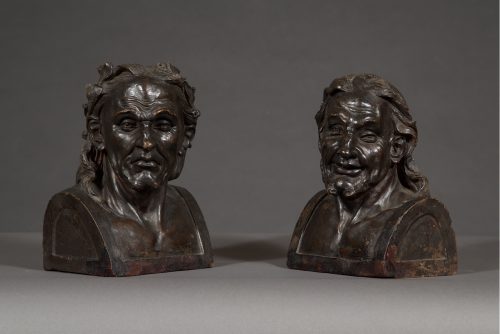
Research
Of dark glazed terracotta.
This interesting pair of painted terracotta busts represents the two pre-Socratic Greek philosophers Heraclitus of Ephesus (d. circa 475 BC) and Democritus of Abdera (d. circa 370 BC). Although they lived nearly a century apart, the duo are usually presented together for their contrasting emotional interpretations of their closely related philosophies.
Heraclitus believed that everything is in a constant state of flux and ever-changing. He is famous for the notion that “no man ever steps in the same river twice, because neither man nor the river are the same.” He maintained that “the soul is dyed the color of its thoughts…The content of your character is your choice. Day by day, what you do is who you become. Your integrity is your destiny – it is the light that guides your way.” He is also known for teaching the idea that “Applicants for wisdom do what I have done: inquire within” and “Even sleepers are workers and collaborators in what goes on in the Universe.” Despite these important realizations, he viewed the affairs of man to be tragic, and approached them with pity and compassion. Thus, he is regarded as ‘the Weeping Philosopher’.
Democritus on the other hand was known in antiquity as ‘the Laughing Philosopher’ because of his emphasis on the value of ‘cheerfulness.’
He was also one of the two founders of ancient atomist theory and held that there are smallest indivisible bodies from which everything else is composed (‘Greek atomos = un-cuttable). Although the ‘atomos‘ may move about in various patterns, they themselves remain unchanged. When we are born, our atoms are held together by a body-shape with a soul inside; while we live, we perceive all that we do by an apprehension of atoms outside of the body being received and interpreted by the soul inside of the body. So when atoms have been combined into one certain form we look at that form and say “That is a book” and when they have been combined in another we say, “That is a tree” but, however these atoms combine, they are all One, ‘un-cutable’, and indestructible. He was quoted as declaring “Nothing exists except atoms and empty space; everything else is opinion” and “We think there is color, we think there is sweet, we think there is bitter, but in reality there are atoms and a void.” Democritus was of the mind that the condition of man is vain and ridiculous and was always found to be laughing at people for their seriousness amidst triviality.
The iconography of Heraclitus and Democritus was widely represented from the Renaissance and Baroque periods to the eighteenth century to symbolize two contrasting attitudes towards life.2 In painting they are often portrayed alongside or holding a globe, representing the world they lament and deride, respectively. Interestingly, the figure of Heraclitus has been used by great Renaissance painters to portray, supposedly, their artistic friends and rivals. It is believed that Bramante modeled his Heraclitus after Leonardo DaVinci, a foil to his self-portrait as Democritus. The weeping philosopher also appears as the likeness of Michelangelo in Raphael’s School of Athens, in the Stanza della Segnatura of the Vatican.
Heraclitus and Democritus are notably portrayed by the 2nd century A.D. author, Lucian, in his satire Philosophy for Sale, in which Zeus and Hermes conduct an auction of various schools of thought, and offer them as a pair. A potential bidder found their extreme positions odd, and ventured to question them on their beliefs. “The phenomenon of a man whose unvarying attitude toward the human scene was expressed by his incessant weeping was curious enough, but it was even more remarkable when balanced by the case of a person whose sole and constant reaction to the same human scene was one of uncontrollable laughter.”3
The source of inspiration for the present busts may have been a set of pendant paintings by Charles-Antoine Coypel IV executed circa 1746 and exhibited at the Salon of that year, to some acclaim as evidenced by numerous contemporary references to them by the critics (figure 1). Democritus in particular shares the same wrinkled countenance and squinting eyes, with his head tilted to the left.
Footnotes:
1. Lutz, Cora E. “Democritus and Heraclitus.” The Classical Journal, vol. 49, no. 7, 1954, pp. 309–314. JSTOR, www.jstor.org/stable/3292600.
2. http://collections.vam.ac.uk/item/O89183/democritus-bust-lucke-johann-christian/
3. Lutz, op. cit.
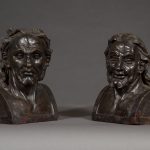
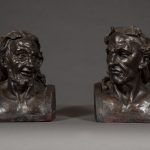
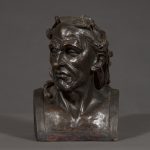

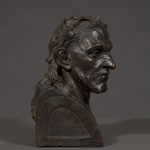
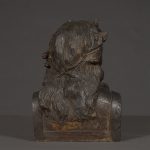
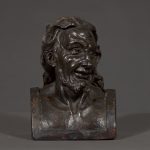
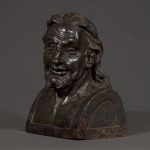

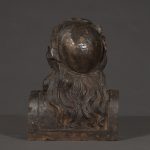

Comments are closed.